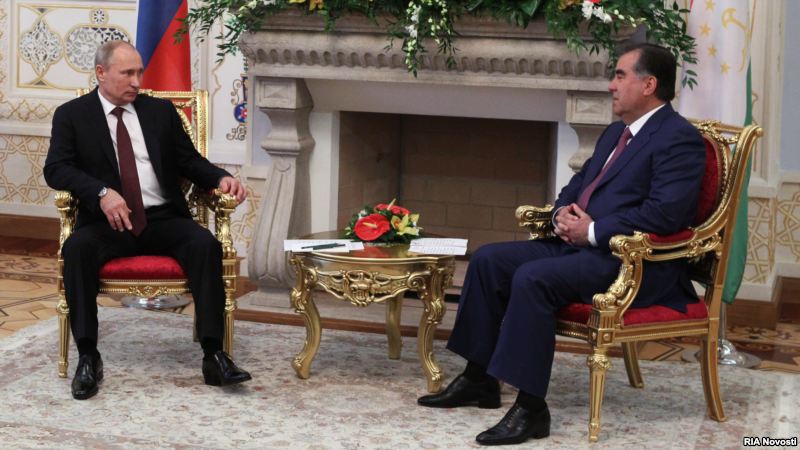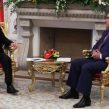
Russia Struggles to Lure Tajikistan into the Customs Union
Publication: Eurasia Daily Monitor Volume: 9 Issue: 186
By:

Russian officials reiterated pledges to boost economic cooperation with Tajikistan. Meanwhile, the authorities in Dushanbe seemed to remain hesitant on some issues, notably the country’s possible membership in the Russian-led economic grouping, the Customs Union of Russia, Belarus and Kazakhstan.
When Russian President Vladimir Putin traveled to Tajikistan on October 4–5, both sides reiterated optimistic official pronouncements. In their joint statement, Putin and his Tajik counterpart, Emomalii Rahmon, noted “positive developments” in the bilateral strategic partnership, including economic ties. They also pledged to increase bilateral trade and develop investment ties, including Russian investment in Tajikistan’s energy and mining sectors (The Russian presidential press-service statement, October 5).
Ahead of the summit meeting, Tajikistani officials voiced expectations of a major “economic breakthrough” during the top-level talks, including in the oil and gas, hydropower, and mining sectors (ITAR-TASS, October 5).
However, actual results of the summit meeting appeared to fall short of these expectations. Both sides only signed relatively minor agreements on energy ties, as well as a migration cooperation blueprint (The Russian presidential press-service statement, October 5). Furthermore, the bilateral energy deal reached was in fact only a memorandum of understanding (MOU) that stipulated signing the bilateral agreement on Russian supplies of oil products to Tajikistan free of Russian export duties. Russian officials disclosed that this agreement was expected to be signed by November 1, even though they argued that the agreement would come as a direct support for Tajikistan’s economy. After the talks, Putin only noted that Russia might consider supporting projects to build medium and small hydropower plants, utilizing Tajikistan’s inland rivers (Prime-Tass, October 5).
In the past, Russia had participated in the construction of the 670-megawatt Sangtuda-1 hydroelectric plant, starting construction in 2005. Russian energy executives had pledged to launch the first unit of Sangtuda-1 in 2007, and then postponed it to 2008. Repeated delays of the Sangtuda-1 projects have been an irritant in bilateral economic relations. Only in July 2009, then-President Dmitry Medvedev and Emomalii Rahmon jointly inaugurated the Sangtuda-1 hydropower plant, which generates around ten percent of Tajikistan’s electricity output (see EDM, August 4).
Apart from Sangtuda, Russia pledged to invest some $2 billion in the Rogun hydropower project. In August 2007, Tajikistan announced the decision to annul a cooperation agreement with Russia’s aluminum giant RusAl to build the $1.3 billion Rogun hydropower plant. Subsequently, Russia confirmed its intent to pursue the Rogun project; yet, little progress has been achieved so far (see EDM, August 4).
In recent years, Russian officials also expressed interest in oil and gas projects in Tajikistan. In March 2006, the head of Russian gas giant Gazprom, Alexei Miller, and Tajikistan’s officials signed a memorandum on the creation of an oil and gas joint venture to develop four gas fields (Gazprom press release, March 28, 2006). However, the joint venture has been slow to materialize, and it was not mentioned during the top-level talks in Dushanbe earlier this month.
Bilateral trade ties have remained at largely unchanged levels in recent years. In 2011, trade between Russia and Tajikistan reached $1 billion. In January–August 2012, the bilateral trade volume amounted to $650 million or 2.7 percent down year-on-year, including Russian exports to Tajikistan of $590 million, according to the Russian statistics. Therefore, bilateral trade appeared to stagnate in recent years. For example, in 2008 trade between Russian and Tajikistan amounted to $1.2 billion or 25 percent of Tajikistan’s foreign trade turnover, according to Tajikistan’s statistics (Regnum, October 5).
In the meantime, Moscow apparently expected to convince Dushanbe to join the Russia-led Customs Union. On October 5, Russian newswires commented that both sides were expected to discuss Tajikistan’s membership in the Customs Union. The head of the Russian Federal Customs Service, Andrei Belyaninov, urged his counterparts in Tajikistan to expedite Dushanbe’s accession into the Customs Union. Moreover, according to Russian officials, Kyrgyzstan would join the union before the end of 2012 (Regnum, October 5).
On December 9, 2010, the union’s member states, Belarus, Kazakhstan and Russia, officially invited Kyrgyzstan and Tajikistan to join the economic grouping (Interfax, December 14, 2010). And in April 2011, Kyrgyzstan decided to start procedures to accede to the union. During the meeting in St. Petersburg on October 19, 2011, prime ministers of the Customs Union’s member states approved Kyrgyzstan’s membership in the union. The union pledged to create a working group on Kyrgyzstan’s accession process, but no timeframe was announced (RFE/RL, October 19, 2011).
Yet despite repeated invitations as well, Tajikistan has remained reluctant to join the grouping. Indeed, the joint Russian-Tajikistani statement issued after top-level talks in Dushanbe on October 4–5 failed to mention the Customs Union at all.
Meanwhile, Dushanbe remains dependent on Tajik migrant workers in Russia, who are estimated to send hundreds of millions of dollars from Russia to Tajikistan every year. The migration cooperation blueprint signed on October 5, thus, came as a positive development for Tajikistan’s authorities (see EDM, October 10).
Russia’s top officials reiterated interest in closer economic ties with Tajikistan during the bilateral summit on October 4–5. However, Moscow apparently struggled to convince Dushanbe to accept its vision of post-Soviet economic integration and join the Customs Union. Now it remains to be seen whether Bishkek’s moves toward the Russian-led economic grouping may sufficiently change Dushanbe’s mind in the near- to mid-future.




